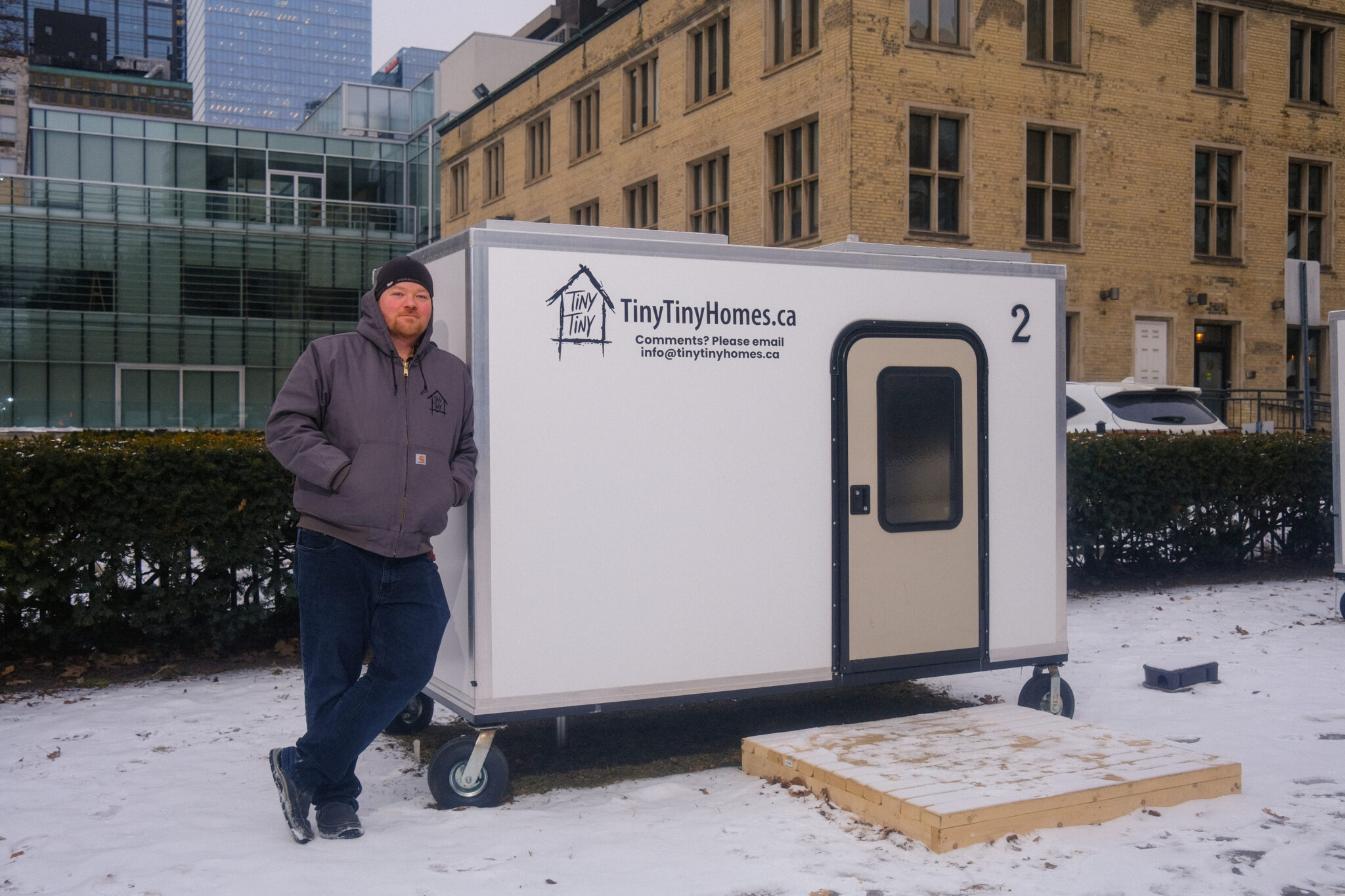Man Uses Savings To Build Mobile Shelters With Heat And Electricity For Homeless

What would you do if you lost everything—your home, your safety, your sense of security? For thousands living on the streets, survival isn’t just about finding food; it’s about making it through the night without freezing to death. In Toronto, where winter temperatures can drop dangerously low, shelters fill up fast, and many people are left to sleep in makeshift tents or on cold sidewalks. Traditional solutions often fall short, leaving the unhoused with few options and even fewer chances at stability.
But one man is challenging that reality. Ryan Donais, a Toronto-based builder, isn’t waiting for bureaucratic solutions—he’s creating his own. Using his construction skills and personal savings, he’s building tiny, mobile shelters that provide warmth, safety, and dignity to those in need. Designed to attach to bicycles and equipped with heat, electricity, and essential safety features, these homes offer more than just shelter; they offer a second chance. His grassroots effort, fueled by community support, is proving that big change doesn’t always require big institutions—sometimes, it just takes one person willing to act.
The Harsh Reality of Being Unhoused
Homelessness isn’t just about lacking a roof—it’s about living in a constant state of uncertainty, vulnerability, and survival mode. For those on the streets, every night is a battle against the elements, exhaustion, and danger. In cities like Toronto, where winter temperatures can plunge below -20°C (-4°F), exposure can quickly turn deadly. Many shelters operate at full capacity, and some unhoused individuals avoid them altogether due to overcrowding, safety concerns, or strict rules that prevent them from bringing personal belongings or pets. Without a secure place to sleep, the body and mind deteriorate rapidly. Sleep deprivation weakens the immune system, making people more susceptible to illness.
The lack of rest leads to cognitive decline, heightened anxiety, and a constant state of alertness that makes it nearly impossible to think beyond the next few hours. The human body isn’t designed to live in survival mode indefinitely, yet thousands of people are forced into this reality every single day.
Terra Sawler, one of the first residents of Ryan Donais’ mobile shelters, knows this struggle firsthand. “When you’re out on the street, you don’t sleep every night. You sleep every couple nights,” she shared, explaining the physical and mental toll of homelessness. Every night spent outdoors increases the risk of frostbite, hypothermia, and even death. And yet, for many, there is no choice. Society often views homelessness as a problem of personal failure rather than a systemic issue, leading to band-aid solutions that fail to address the root causes. Traditional emergency shelters may offer temporary relief, but they don’t provide stability or security—two things that are essential for getting back on one’s feet. Without alternative solutions, many are left to fend for themselves in a world that too often looks the other way.
Mobile Shelters That Save Lives
When traditional solutions fall short, innovation steps in. Ryan Donais isn’t waiting for large institutions to solve the homelessness crisis—he’s taking action himself. Using his construction expertise and personal savings, Donais has designed compact, mobile shelters that provide warmth, security, and dignity to those who need them most. Unlike conventional emergency shelters, these units are built to be both portable and practical, offering a private, weatherproof space that unhoused individuals can call their own. Each tiny home is designed to be attached to a bicycle, allowing users to remain mobile while still having access to a secure, insulated place to sleep. This unique approach not only provides shelter but also respects the autonomy of those who receive them, offering an alternative to overcrowded, restrictive shelters that many avoid.
But these aren’t just makeshift boxes—they are fully equipped survival units. Each structure costs approximately $10,000 to build and includes essential features such as heating, electricity, running water, smoke detectors, and carbon monoxide alarms. Built to comply with e-bike regulations, they can legally operate in bike lanes, giving residents greater freedom to move safely through the city. More than just a temporary fix, these shelters are a lifeline. They provide unhoused individuals with the ability to sleep through the night without the fear of freezing, theft, or assault. In a world that often ignores their struggles, these small mobile homes offer something even more valuable than shelter—stability, safety, and the dignity of having a space to call their own.
The impact of this initiative extends beyond just the individuals who receive these homes. It challenges the way society thinks about homelessness and solutions to it. Instead of waiting for large-scale housing projects that may take years to materialize, Donais’ work proves that immediate, life-saving interventions are possible. His project is a reminder that sometimes, the best solutions come not from bureaucracy, but from people willing to act.
Overcoming Skepticism: The Pushback and Challenges
As with any unconventional solution, Donais’ initiative has faced its share of skepticism. Some critics question the long-term viability of these mobile shelters, arguing that they are only a temporary fix rather than a sustainable solution to homelessness. Others worry about safety concerns, mobility restrictions, and how cities will regulate them. While these concerns are valid, they overlook a critical truth—people living on the streets don’t have the luxury of waiting for perfect, long-term solutions. They need help now. These shelters aren’t meant to replace permanent housing, but they provide immediate relief for those who might not survive another winter outdoors.
Navigating city regulations has been one of the biggest challenges. Urban infrastructure is rarely designed with mobile shelters in mind, and legal gray areas regarding their placement and use create roadblocks. However, by designing these homes to comply with e-bike regulations, Donais has found a way to work within the system while providing real, immediate relief. His shelters don’t take up much space, don’t require government funding, and offer an alternative for those who don’t feel safe in traditional shelters. Rather than being an obstacle, cities could embrace projects like this, integrating them into broader homelessness solutions instead of resisting them.
Criticism often comes from those who don’t fully understand the realities of homelessness. It’s easy to dismiss innovative ideas from the comfort of a warm home, but for someone sleeping on frozen concrete, a mobile shelter could be the difference between life and death. Donais’ project isn’t about solving homelessness overnight—it’s about saving lives in the present while society works toward larger solutions. If anything, his work should serve as inspiration, proving that individuals can make an impact even when governments and institutions fall short.
Funding and Community Support
Big change often starts with small acts of kindness, and Donais’ project is proof of that. What began as a personal mission fueled by his own savings has now grown into a community-driven effort, supported by people who believe in practical, immediate solutions. Through crowdfunding platforms like GoFundMe, donors from all walks of life have come together to help fund the construction of these mobile shelters. Each unit costs around $10,000 to build—a fraction of what traditional housing initiatives require—but every dollar makes a tangible difference. This grassroots support shows that when people see a solution that works, they’re willing to step up and be part of the change.
Unlike large-scale government programs bogged down by bureaucracy, Donais’ initiative is agile and immediate. The money raised goes directly into materials, construction, and delivery, ensuring that every contribution has a direct impact. This kind of transparency and efficiency is why so many people are willing to donate. It’s not just about charity—it’s about investing in something that works. While long-term housing policies remain tangled in political debates, Donais and his supporters are proving that real help can happen now, one mobile shelter at a time.
But funding isn’t the only form of support that keeps this initiative going. Volunteers, builders, and local advocates have also played a crucial role in bringing these shelters to life. The project is sparking conversations about how communities can come together to address homelessness in ways that go beyond waiting for government intervention. It’s a reminder that real change doesn’t always start from the top—it often begins with people who simply refuse to look away.
The Bigger Picture: Rethinking Homelessness Solutions
For years, governments and organizations have searched for large-scale solutions to homelessness, but the crisis continues to grow. Shelters provide temporary relief, yet they often come with overcrowding, strict rules, and safety concerns that make them unappealing or inaccessible to many unhoused individuals. Affordable housing programs promise long-term solutions but can take years to implement, leaving thousands stranded in the meantime. Ryan Donais’ initiative challenges the idea that only massive institutional efforts can create change. His work proves that sometimes, the best solutions come from individuals willing to take action immediately—no bureaucracy, no delays, just direct impact.
Beyond providing physical shelter, these mobile homes redefine how society perceives homelessness. Too often, the issue is viewed through a lens of pity or blame, reducing individuals to statistics rather than recognizing their humanity. Donais’ project takes a different approach—it treats unhoused individuals with dignity, giving them not just a roof, but autonomy and security. By allowing people to remain mobile and independent, these shelters offer more than just survival; they offer a renewed sense of agency in a world that often leaves them powerless.
This initiative also raises a bigger question: What if more people took this kind of action in their own communities? Solutions don’t always have to come from top-down policies. Localized, creative interventions—whether it’s mobile shelters, community-supported food programs, or transitional housing initiatives—can be just as impactful. Donais’ work isn’t just about helping a handful of people; it’s about inspiring a shift in mindset. If one man with limited resources can create real change, imagine what could happen if more people stepped up with their own ideas to tackle homelessness in ways that work now, not years down the road.
Featured Image Source: Tiny Tiny Homes Toronto Website
Loading...






